| |
T O P
NEXT
Group Members
- Eduardo Gallofin - Develop interfacing software (Group Leader)
- Michael Fernandez - Develop interfacing hardware
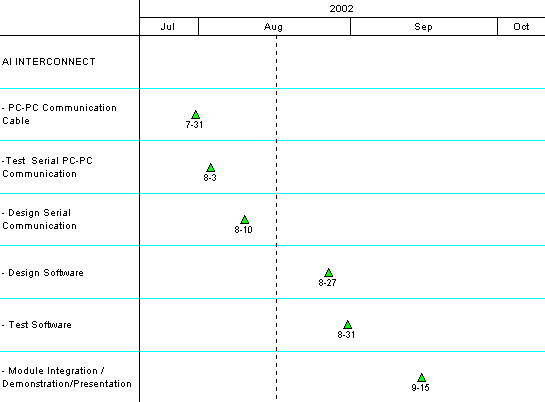 ABSTRACT
ABSTRACT
The Automated House project provides a model for a house with components monitored and controlled through a network of computers and is designed and developed for the AI House Project of the Electronics, Communications and Computer Engineering Department of the Ateneo de Manila University. The model has five modules. The Security and Access and the Environment Control are the monitor modules. They watch the parameters prevailing in the AI House and control the conditions in there to be consistent with given set-points. The Status Monitor/Control and the Remote Administration modules are the "user-interface" to the system. The user to provides the input parameters for all the modules to follow. The Interconnection Module manages the communication among modules.
All the computers that are performing specific tasks for the AI House are connected to the Central computer via their serial ports. They communicate through a command file and a status file.
Communication takes place via the serial ports of the PCs, which by design, are onePC-to-onePC. A specially-designed hardware and software combination converts them into a onePC-to-manyPCs for the PC managing the interconnection process and manyPCs-to-onePC for all the other PCs.
The danger of data crash is eliminated by the use of a specially crafted communication protocol, where each computer is given an ID code composed of two bytes. One byte tells the addressed computer to send a status file or a command file, as inherent in the computer's function. The other byte tells the addressed computer to receive a command or status file.
Updating is "by exception", i.e., data transfer occurs only if the data has changed from the last instance of transfer. This assures fast refresh time.
|
| |
T
O P NEXT
PREVIOUS
Group Members
- Donnie Baņez - Main console, software, and intercom control (Group Leader)
- Janice Tanqueco - Motion detectors, log-in count, miscellaneous features
- Honeylou de Guia - Motion detectors, log-in count, miscellaneous features
- Marjhorie Caparas - Voice recognition submodule
- Elissa del Castillo - Voice recognition submodule
- Mija Cu - Voice recognition submodule
- Paul Anthony Woo - Door control and lock system
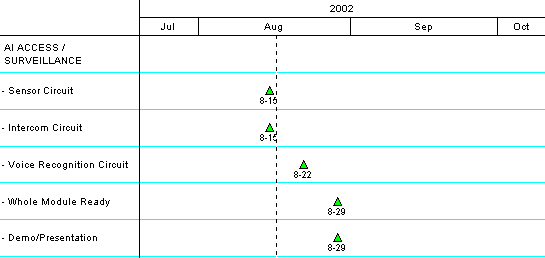 ABSTRACT
ABSTRACT
With the development of technology, more sophisticated security and access systems are made available in the market. However, they are accessible to a limited sector of the society due to their high cost. Thus, there is a need to develop a system that is less expensive but comparable to commercially available security and access systems.
This project develops an alternative security and access system that makes use of economical small-scale circuits interfaced to a computer. It features a presence triggered log-in system, implemented using an infrared emitter-detector pair, a voice-activated access protocol, using C (the main programming console) and MatLab (for voice recognition), and an intercom system. C and MatLab communicate through a text file. The overall system is designed to include a "time stamp" for detections, and includes a valid access database to create user-event associations. It is integrated via the enhanced parallel port of the personal computer.
The command received from the central computer (from the status control - door lock and intercom) is given priority. If the access system fails, management of the system is done by the status controller from information received from text messaging module.
Unauthorized intrusions activate a module that sets emergency. These events are reflected at the status control monitor, where a combination of hardware and software system calls the attention of the user to such events. An annunciator light goes on and an annunciator warning sound is activated at the same time.
|
| |
T
O P NEXT
PREVIOUS
Group Members
- Mark de Guzman - Hardware and Software Interface (Group Leader)
- Ria Reyes - Hardware interface and Speech Recognition
- Mark Bendicion - Radio Control
- Antoine Bunnell - Lighting Sensor and Control
- Zorayda Marcojos - Air-Conditioner Sensor and Control
- Sol Magsuci - Lighting Control
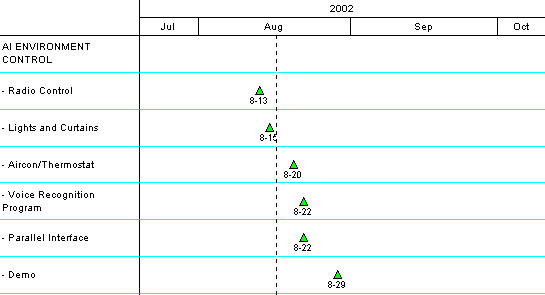 ABSTRACT
ABSTRACT
The environment module controls the intensity of the lights, the temperature of the air conditioner, and the volume and station of the radio, via speech command. Interfacing is made through the parallel port using C++ and speech control is processed through a MatLab program that sends control signals through an outputting function. Main processing is accomplished in MatLab and control signals are sent to the C++ functions using text files. Although speech command takes precedence, the system is also controlled through keyboard (PC) and via cellphone text messages. The lights and air conditioner are controlled by sending signals to an R-2R ladder circuit coupled with appropriate operational amplifier configurations. The lights and the air conditions of the room are monitored the environment through a light intensity detecting circuit and a temperature sensor connected to ADCs. Depending on the signals detected, a request for parameter change is sent to,
processed and sent back by the computer to the requesting I/O. Radio volume is altered by digitally changing the input resistance of an operational amplifier circuit. The radio station is selected either by resetting the station to the start of the FM band or by scanning for the next FM band.
All the devices are turned on at the start of the program. Operation of functions are adjusted in accordance with the commands from the keyboard, or text files from the cellphone. A file reflecting the current status of the system is always updated.
Safety policies take precedence over any command from any source.
|
| |
T
O P NEXT
PREVIOUS
Group Members
- Adrian Serohijos - Web/Internet Administration (Group Leader)
- Melisande Tupa - Interface of text files with other modules
- Ronald Idjao - Mobile pone and PC interface
- Ian Esguerra - Web/Internet Administration
- Juphel Ace Guerra - Response of PC to phone
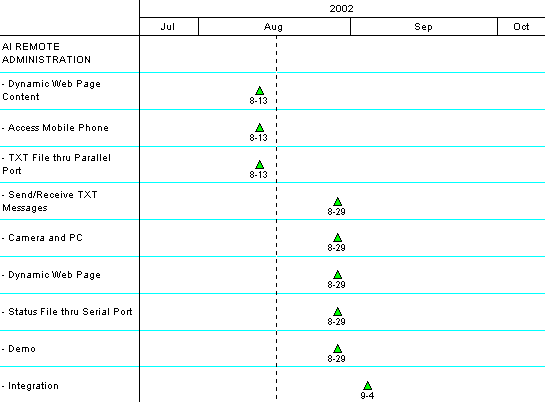 ABSTRACT
ABSTRACT
The Automated House provides a completely controlled and automated home system, which consists of five modules. The Remote Administration module interacts with the rest of the system through a status file that is transmitted via the personal computer's serial ports. The modules automatically reply to requests made by the remotely located administrator by sending the contents of status file through SMS. Emergency interrupts are, likewise sent to the administrator when abnormal conditions are sensed within the AI House. The software for this mobile interface is coded in Visual C++ and uses ActiveX controls. The administrator can likewise extract information regarding the status of the house through dynamic web pages and send commands to the central computer (control) by updating the status file on-line. A webcam that continuously acquires information is interfaced into the module. Still images of the house are automatically uploaded to the site to provi
de more extensive information.
|
| |
T
O P NEXT
PREVIOUS
Group Members
- Carla Nuņez - Interpreting Text Files and Logging (Group Leader)
- Joey Costoya - Graphical Representation and PC Interface
- Erees Macabebe - Hardware Interface for Emergency Conditions
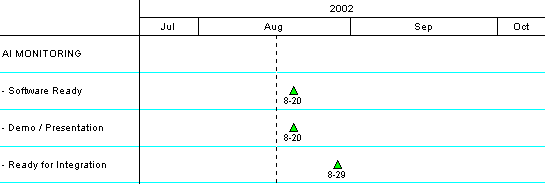 ABSTRACT
ABSTRACT
To fully reap the benefits of an automated house (AI House), there is a need for a monitoring system to keep track of the status of each individual device and to control these from one computer. The Status Monitor is a program that provides a view of the house's current settings and conditions. The information is acquired via a file sent by the central computer that communicates with all other modules. This file is interpreted to update the settings to their most recent recorded values and the new settings are reflected in the graphical and textual display. The Status Monitor also allows the user to input new settings through the keyboard or through SMS. The SMS input is received as a file from a remote administration module that is also connected to the Status Monitor. These inputs are passed to the central computer, to be disseminated to other modules as a command to change their settings. All events received and transmitted by the Status Monitor ar
e recorded in a text file. This is similar to a control room in power plants and manufacturing processes.
The module indicates an emergency, such as, unauthorized intrusion, or any abnormality, activating an indicator lamp and activates a sound generator to call the attention of the operators of the emergency.
|
| |
T
O P NEXT
PREVIOUS
Group Members
- Jason Saba
- Alejandra Jayme
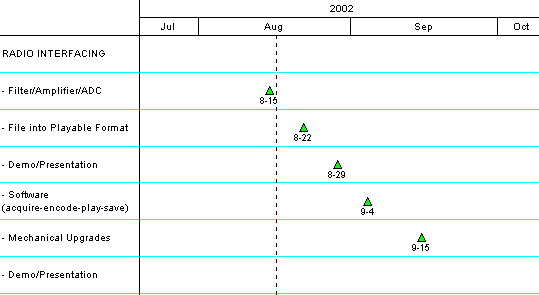 ABSTRACT
ABSTRACT
The aim of this project is to interface an ordinary AM/FM radio to a computer, and with the connection, be able to, one, play sound coming from the radio through the computer's sound card, and two, save the radio broadcast into a playable file format for future use. An additional aim is to control the volume of the radio via software. The circuit will be connected to the headphone jack of the radio and digitizes the sound for input into the PC's parallel port. A software will be created to control the circuit and convert the input stream to playable "wav" format. Radio volume is altered by scaling the data stream that has been taken into the PC.
|
| |
T
O P NEXT
PREVIOUS
Group Members
- Lou Marvin Bautista (Group Leader) - Convert template into "sendable" text
- Bonn Jonel Pua - Convert template into "sendable" text
- Kelwin Chua - Convert template into "sendable" text
- Sherwin Ian Bedia - Process voice into template
- Shei Audrey Fuertez - Process voice into template
- Jaimee Felix Marquez - Process voice into template
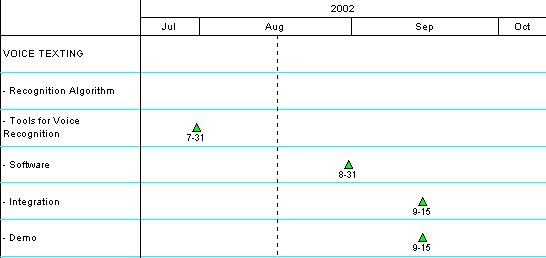 ABSTRACT
ABSTRACT
This project involves the design and implementation of a voice-texting system that allows the sending of SMS messages by way of voice-recognition and computer interfacing, and supports user-notification of incoming messages. This is intended to facilitate the easier transmission of commonly sent messages saved as templates simply through voice identification rather than typing the whole message in the mobile phone's keypad, which takes more time and energy, and involves greater susceptibility to committing typographical errors.
In this system, the user speaks to a microphone connected to a computer. A program written in Visual Basic accesses the voice from the sound card and saves it as a wav file. The voice is then compared in terms of wavelength with pre-recorded voices already stored in the computer. When a match occurs, the program accesses the corresponding text file or template containing the specific message to be sent by SMS. The message is then passed on to the cellular phone interfaced with the computer through the serial port.
A hardware circuit connected to and controlled by the parallel port indicates whether the message has been sent or not, and the number of messages sent and received. At the same time, the program alerts the user when a message has been received. The computer then proceeds to showing the message to the user and activates a synthesized voice program that speaks out the message received.
|
| |
T
O P NEXT
PREVIOUS
Group Members
- Allan de Jesus - Group Leader
- Rhyan Andrade
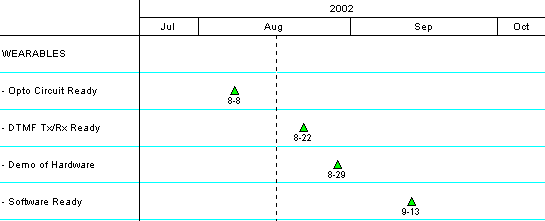 ABSTRACT
ABSTRACT
A key glove provides an alternative and portable input interface for wearable computing. As research on wearable technology increases, the design of an unobtrusive and portable input device becomes invaluable. This project aims to provide inputs similar to the keys of a keyboard. However, unlike the keyboard, the keys are directly fitted on the glove. Furthermore, the key glove utilizes an interface similar to that of cellphones where several keys are encoded on a single contact. This reduces most of the keys of a standard 101-key keyboard into 11 contacts only. Thus, this improves the ergonomics of the keyer and makes it easier for the user to learn the configuration. Such a design allows the user to do multiple tasks and to achieve convenience and portability.
|
| |
T
O P NEXT
PREVIOUS
Group Members
- PASICOLAN, Pocholo (Group Leader) - RC control dissection
- CHUA, Jhozeph - RC control dissection
- CUYEGKENG, Marty - RC car dissection
- LAZO, Christian - RC car dissection
- LEE, Brey - RC car dissection
- MENDOZA, Jenard - RC car dissection
- AMPARO, Denis - LAN research
- ARANAS, Erika - LAN research
- RELLOSA, Aissa - LAN research
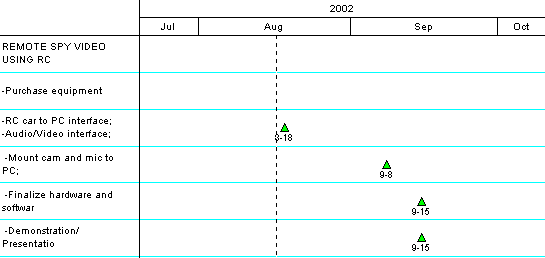 ABSTRACT
ABSTRACT
Unmanned surveillance is of particular use when investigating situations which pose risks to human lives or in certain circumstances wherein survey-related tasks done directly by man prove to be too cumbersome. Wireless communication via radio frequency is a common mode for controlling remote surveillance devices since the operator is not limited by line of sight.
The group attempts to build a remote video surveillance device using available RC appliances. In essence, a wireless camera is mounted on an RC toy tank to serve as a functional remote video surveillance device. The 27 MHz remote control toy tank will be responsible for motion on land and a 2.4 GHz wireless camera will provide for off-location video. In addition, these two RC devices will be interfaced to a computer so that the movement of the tank and the viewing of the off-location video will be handled by a software program. In more detail, the mechanical switches of the remote control will be replaced by mechanical relays which are connected to the parallel port of the computer. A circuit is used to optically isolate the parallel port from the remote for safety purposes and at the same time, step up the low power output of the parallel port so that triggering the relays will not be a problem. A Visual Basic program is responsible for triggering the
correct combination of relays for the desired tank motion. A TV tuner card will be the interface for the video signal from the camera and this signal will also be used by the Visual Basic program. Essentially, the program will display what the camera sees and will wait for keys to be pressed that would move the remote device. In addition, the group will further increase the controlling distance between the operator and the remote device by accessing the software control program from a LAN connection.
|
| |
10 - Proximity Sensor
T
O P NEXT
PREVIOUS
Group Members
- Jose I. Amanse Jr.
- Jonathan Andrew Ong
 ABSTRACT
ABSTRACT
The goal of the project is to build a device that can be used to sense the proximity of an object. A possible application would be to detect whether an obstacle is in the path of an automobile, especially if there is imminent danger of a collision. The device could be useful to automobile drivers when maneuvering for parallel parking, or when backing up against a wall. The proximity sensor could serve as a warning device which could send or trigger a signal to the driver when the pre-programmed distance against an object is reached.
The main component of the project is the Murata Ultrasonic transmitter-receiver pack. The pair is made to interact with each other through a 40KHz signal. The transmitter is driven with a 40 kHz square wave. The amplitude of the 40 kHz sine wave generated by the receiver changes inversely as the distance between the transmitter-receiver pair changes.
The main bulk in the completion of this project is the conversion of the analog signals received from the receiver into digital format which could be interpreted and analyzed by interfacing the digitized outputs to a computer through an enhanced parallel port. A program then displays the current distance, depending on the outputs from the circuit. The program sends an alarm, once a predetermined distance is measured.
|
|









